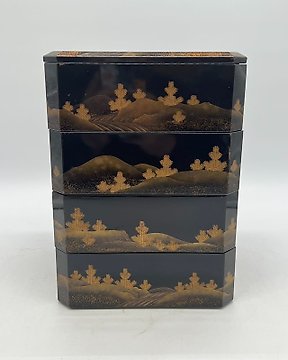
輪島塗Wajimanuri lacquerware 倉澤 Kurazawa - Pudełko (6) - Gold-Makie - Drewno, Lakier, Złoto
Nr 81851827

Nr 81851827

A four-tiered lacquered box with a design of Cranes and Pine Trees in gold lacquer.
A "juubako" is a container in a box shape used in Japan for packing traditional meals. It is designed to be stacked in multiple tiers. The box is black lacquered with intricate gold patterns, giving it a delicate and elegant appearance.
"Kin maki-e" refers to a traditional Japanese decorative technique that involves applying gold leaf to create intricate patterns and designs. This technique is commonly used in the surface decoration of items such as lacquerware. Below is a brief explanation of the characteristics and methods of "Kin maki-e."
Kin maki-e involves affixing thin gold leaf onto surfaces, primarily of objects like lacquerware or wooden items, and then applying a design known as "maki-e" using lacquer. The gold leaf, being extremely thin and transparent, produces a beautiful shimmer when applied over the lacquer, imparting a luxurious and elegant appearance to the decorated item.
The creation of Kin maki-e requires great delicacy, and artisans must possess precise brushwork and meticulous skills. This technique holds significant importance as part of Japan's traditional crafts and is widely employed in the decoration of art and craft items, as well as in gift items.
The crane (tsuru) 鶴:
The crane (tsuru) is considered a symbol of auspiciousness in Japanese culture and tradition. Here are some symbolic meanings and features associated with the crane:
Longevity and Prosperity: The crane is a symbol of longevity, and the folding of a thousand paper cranes, in particular, is a traditional practice to wish for recovery from illness, longevity, and happiness.
Virtue and Nobility: Regarded as an elegant and beautiful creature, the crane symbolizes virtue and nobility, reflecting these qualities through its graceful posture and majestic flight.
Affection and Eternal Bond: Due to the crane's lifelong commitment to a single mate, it is seen as a symbol of affection and an eternal bond between partners.
Good Luck and Auspiciousness: The soaring flight of the crane is believed to bring good luck and auspiciousness.
These characteristics make the crane a commonly used symbol in Japanese literature, art, and various celebrations and festivals, representing positive and meaningful qualities.
The pine tree (matsu) 松:
The pine tree (matsu) holds various symbolic meanings in Japanese culture and beyond. Here are some key characteristics associated with the symbolism of the pine:
Longevity and Strength: The pine is a symbol of longevity and strength due to its robust nature. Being an evergreen tree, it retains its greenery throughout the seasons, signifying enduring strength.
Permanence and Eternity: Because the pine remains green even in winter, it symbolizes permanence and eternity. Particularly in Japan, its ability to thrive vigorously during the winter is admired.
Happiness and Prosperity: The pine is considered a symbol of auspiciousness, bringing happiness and prosperity. Consequently, it is often used in celebrations, New Year's decorations, and auspicious occasions.
Purity and Nobility: The vibrant green color of the pine symbolizes purity, and its tall and upright stature is associated with nobility.
These qualities make the pine tree a widely used symbol in Japanese literature, art, gardens, and various festive and ceremonial contexts, representing positive and profound symbolism.
Juubako:
Height: 35 cm
Width: 24 cm
Depth: 24 cm
Weight: 3.2 kg
Condition:
The condition is good. There may be some dirt, stains, and scratches. And this type of Juubako is very delicate. Please be cautious when handling. I believe you'll find it surprisingly clean and beautiful, considering it's old age. I have posted many photos, so please take a look.
Atention:
The items listed for sale are all used collectibles. Please consider them to have signs of aging, such as stains, scratches, scuffs, tears, discoloration, fading, fraying, and changes in thread color. We will post as many photos as possible to make it easy to understand. As these are old items, we appreciate your understanding before making a purchase.
Shipping:
The lot will be carefully packaged and shipped from Japan.
We will use either DHL or FedEx for a safe and secure transportation. It usually takes about 2-3 weeks for delivery, and the package will be shipped with a tracking number.
Import duties, taxes, VAT, and any other charges are not included in the item price and shipping cost. Please check your country's import duties before bidding.
013022370219
Jak kupować w serwisie Catawiki
1. Odkryj coś wyjątkowego
2. Złóż najwyższą ofertę
3. Dokonaj bezpiecznej płatności